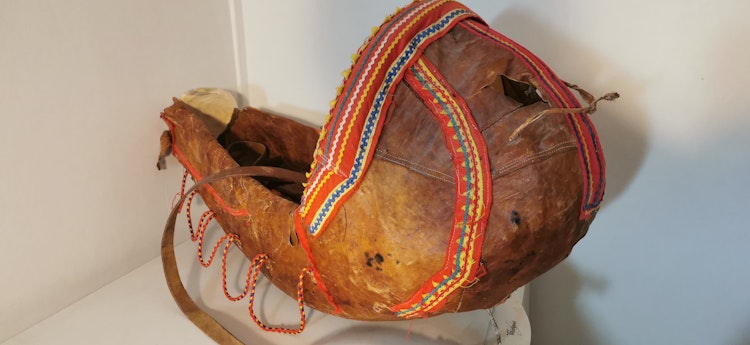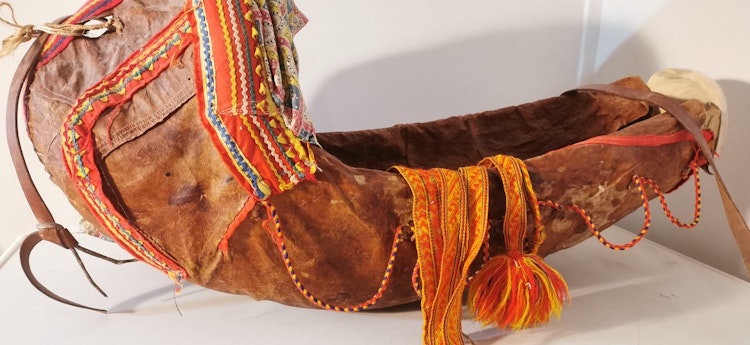Inga-Wiktoria Påve
The Sámi gietkka, a cradle for newborn children, has an ingenious design suited for a nomadic lifestyle. In this text, duojárat and couple Fredrik Prost and Inga-Wiktoria Påve talk about two old cradles that were left in their care from each of their families, and how they made them fit for new generations with the help of each other, their ancestors, and sketches from the 1930s.
The dearest and most precious being one could think of is a newborn child. Cradles all over the world have been ornated and crafted with both care and love, so too the Sámi gietkka.1 The gietkka is a very special object that connects Indigenous peoples throughout Siberia, all the way from Mongolia to Sápmi. Cradles of similar design have been made by many nomadic peoples in these areas, which speaks to the deep cultural roots between Sápmi and Siberia. This makes the gietkka an even more intriguing piece of art.
The gietkka is made with the purpose of being light and portable for the nomadic lifestyle, but of course it has to be beautiful too. The gietkka could be one of the best Sámi displays of skilled work of the hands. It is function, pride, and beauty merged in one object. It is also, in most cases, a project that requires collaboration between two Sámi crafters, duojárat in Northern Sámi.2
It is not, however, just any project. There are rules and unspoken procedures that need to be honoured during the process. When expecting a child it is not allowed to start, or even plan, to make a gietkka. Some old sayings even state that it is not even allowed to speak of making a gietkka before the child has arrived safely into the world. This can of course result in a bit of a hurry when the long-expected person finally arrives. It can be a daunting task to begin work on a gietkka when you have just recently had a small child, therefore it can play out more like a collaboration between families rather than between just the expecting couple.
Silent preparations
As we know, it is not encouraged to speak about the gietkka before the child has been born, but preparations are often being done without words. As an example, it could be that the expecting father has spotted a suitable material for the wooden frame of the gietkka. He can then just casually mention this during conversation with, for example, his brother. The brother can then just nod without saying anything and go out on his own and get the material, which he roughly cuts into shape before storing it out of sight.
It can also be that a relative of the expecting mother will start to weave bands. It can be a sister or aunt who, just in case, prepares bands in case they might be needed at some point. This is also done without speaking about it. There can also be especially nice leather that is put aside, just in case. All of this is done, of course, without words or agreement. It could also be that both boys’ and girls’ bands are woven just as a matter of practice, of course.
Then, when the expected person has safely arrived, it just so happens that there are some half-baked materials at hand for a gietkka. The resting place for the precious newcomer is then magically finished within days, rather than weeks or months. Then there are usually additional replacement bands woven for future use, just in case.
Resurrecting the skuvdu
Knowing all this, it is easy to see why the gietkka is inherited and passed on through families. Sometimes a gietkka has been worked on for generations and been given new bands and new life many times. Two such projects happened to fall into our hands a couple of years ago. One of them involved the making of a skuvdu, which is a protective winter casing for the gietkka. A skuvdu is made from the fur on the lower legs and forehead of the reindeer, and is rarely seen these days. It fell out of use in the early 1900s when wool blankets became more available through trade with Scandinavian farmers. It is made from perishable materials, and the nomadic life doesn’t allow for carrying any extra weight, so most of them were lost.
In 2017 Inga-Wiktoria decided to resurrect the skuvdu, and crafted one of only a few made in modern times. A skuvdu has to be made to fit a gietkka perfectly, so she chose to use her parents’ gietkka as a model for her project. This gietkka was a classical collaboration between her parents, made in the late '80s and now used for making a skuvdu. As mentioned, not many old skuvdus have survived, so she needed examples of how they are made. One of the examples she used was an old sketch made by the ethnologist Ernst Manker when he visited Fredrik Prost’s family in the 1930s. He drew the skuvdu of Inga-Maria Sevä, who was Fredrik’s great-grandmother, so the project became a sort of collaboration of families through time and in spirit. A skuvdu is a massive project and demands very special materials, a real test of a duojár’s abilities. The skuvdu that Inga-Wiktoria produced is a true testament of not only her skill of the hands, but of the ingenuity our ancestors had. A skuvdu is also one of those objects that by chance just so happens to be materials for when a child is born.

Restoring a family heirloom
The other project that ended up in our workshop was the old, worn gietkka of the Prost family, which was originally made as a collaboration between Fredrik’s grandparents. Several generations have used this gietkka; first it was Fredrik’s mother and her siblings, and eventually all of his siblings. When he was born, it was in such a bad shape that it had been retired and stored in an old shed. It eventually ended up in his cousin’s hand through inheritance. The leather was torn, dry, and as brittle as paper. The wooden frame was cracked, and the bands were faded and dirty. The gietkka that had once been the pride of the family was now a shadow of its former splendour, something had to be done. We were asked to restore it and so we began to work on it.
First, the cracked frame and footboard had to be restored, which Fredrik did with the intention of saving all of the original material. In the end, the only thing that had to be completely replaced was the cracked footboard. When the frame was restored, Inga-Wiktoria could begin to work on replacing the dry leather. She took extra care to save all of the original bands from the '30s that were carefully cleaned and ironed to once more bring out the colour in them. She succeeded in this, and when the cleaned bands and cover were sewn back on the new leather, the old gietkka truly came to life again. Our ambition was to save as much of the old material as possible, in order to preserve the soul and spirit of this old family heirloom. When it was finished, it was an absolute joy to look at and handle. It was truly the joy of making, and we were satisfied but also, a bit sad to give it back to Fredrik’s cousin.







Keeping our ancestors’ craft alive
Both of these projects were made in the spirit of keeping the fire of our ancestors’ craft alive and well. It is through everyday objects like these that we do this best. The gietkka and skuvdu have their natural place in the rhythm of life, and thus will survive and thrive as long as we keep the knowledge alive. In the case of the skuvdu, this was about bringing back that knowledge into our modern age. It is an object that was on the brink of being forgotten, and now is brought back through hard work and love for our ancestors’ craft. In the case of the gietkka, it was about blowing back life and beauty into an old, treasured gietkka. This was not just about restoring an old, worn gietkka, but also about keeping family traditions alive. Every Sámi area has its own traditions, and every family within that area has their unique traditions. Two families, two projects.